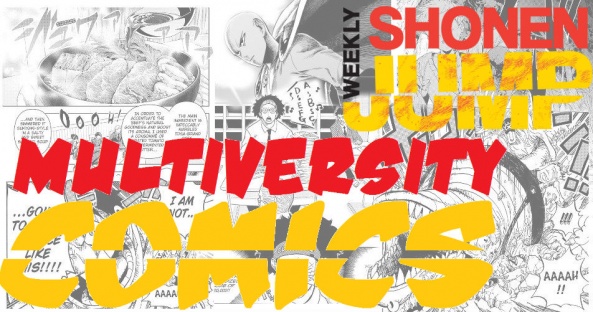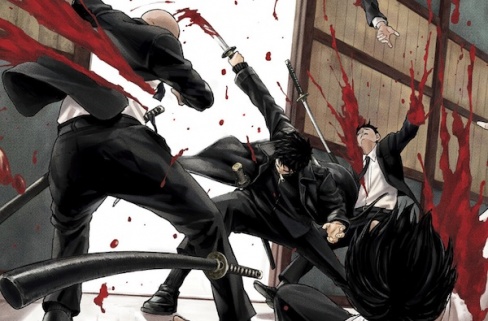
Welcome to This Week in Shonen Jump, our weekly check in on Viz’s various Shonen Jump series. Viz has recently changed their release format, but our format will mostly remain the same. We will still review the newest chapters of one title a week, now with even more options at our disposal. The big change for our readers is that, even without a Shonen Jump subscription, you can read these most recent chapters for free at Viz.com or using their app.
This week, Rowan checks in with “Kagurabachi” If you have thoughts on this or any other current Shonen Jump titles, please let us know in the comments!

Kagurabachi Chapter 1
Written and Illustrated by Takeru Hokazono
Reviewed by Rowan Grover
We’ve seen an increase in hobbyist or craft-type Shonen these days, perhaps due to the success of “Akane-banashi”. It’s a Shonen type that has long simmered in the manga publication, but it’s never felt as mainstream as it does now. Enter “Kagurabachi”. Hokazono’s latest series feels perfectly geared towards Shonen-style action as it centers around the craft of katana forging, with a touch of supernatural woven in. Does it hit the same highs its peers do? It’s hard to give a definite answer, but I’m not too optimistic about it at this stage.
The first half of the book details the origin of our protagonist Chihiro, and his father Kunishige. Despite lacking the intriguing supernatural elements of the latter half, I find this section to be the most compelling and engaging part of the chapter. We spend time being shown the intricacies of katana forging and Hokazono gives this the space it needs to breathe. Personal relationships are developed in the middle of displaying quiet, masterful craftsmanship. We see how devoted Kunishige is as a father in how he shares his knowledge with his son. This is accentuated with little personal insertions like Kunishige buying more goldfish for their aesthetic and spiritual value. It all feels like filler but in the best possible way. The book creates a cozy atmosphere for us to get a feel for these characters.
The second half of the book speeds up for a more action-oriented tone and as I mentioned earlier, infuses some fantastical elements. I’d like to get this out of the way first. While I think the fantasy elements are interesting and tint the action visuals with extra oomph, they feel superfluous and almost detract from the genuineness of the story. It feels like the focus is moving away from the intricacies of katana craft and towards becoming another generic demon-centric revenge story, which is a shame!
Chihiro moves from being an awkward but well-meaning shy kid to a straight-up anti-hero edge lord, and while I understand the reasons why, it comes off as trite here. Additionally, the antagonists are complete cannon fodder and I can barely remember them outside of the quirky facial hair they sport. They talk like criminals, they act mean, and they end up as a means to show how much of a badass Chihiro has become. If it didn’t have the same characters, I’d be hard-pressed to pick these two parts as the same manga, the whiplash is that strong.
Hokazono’s art is just as much of a mixed bag, if at least a little more consistent than the writing. They have a strong understanding of shifting visual style to imply tone, which is quite impressive. The initial style feels closer to a slice of life or gag manga. It’s light on linework with characters that feel closer to cartoons than anatomically correct humans, and the facial work is drastic and expressive. This is generally when conversation is happening between Chihiro and his father or other colleagues. Hokazono shifts into a much more line-heavy, detailed style when portraying a scene that emphasizes a skill or craft. When Kunishige is in the thick of forging katana, the shading is heavy, the facial detailing features more intricacies like sweat or dirt. It shows the intensity and respect that the craft deserves, which Hokazono handles well.
The only gripe with this shifting style I have is that the lighter, cartoony sections are not executed as well as the more detailed scenes. This is more present in the second half of the book when the tone is more erratic. Hokazono doesn’t know how to give their protagonist Chihiro any expression outside of blank solemnity in the lighter sections. Even this emotion feels incredibly flat, which is not helped by his characteristic semi-circle droopy eyes. It makes the pacing feel bumpy when you have these detailed sections that really sing and filler sections that feel half-hearted.
Overall, this feels like a book that hasn’t quite found it’s footing yet, but shows a lot of promise. If Hokazono can find a way to balance the two disparate aspects of the story, I think this premise could sing. At this stage, it falls a little flat, with bright points hidden amongst more forgettable passages.
Final Score: 6.0 – A debut that feels like it has so much more to give than it actually does.






